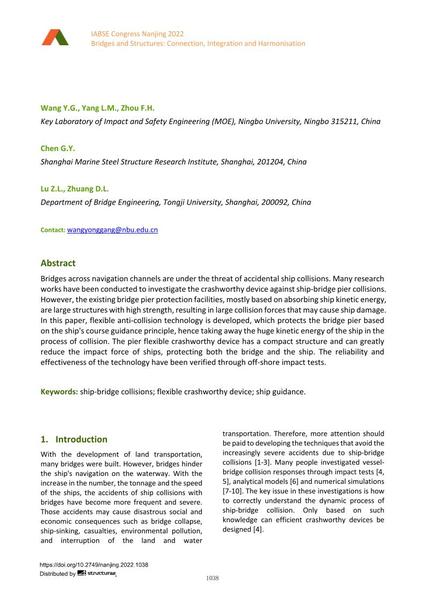Flexible Protection Technology of Bridge Pier against Ship Collision

|
|
|||||||||||
Bibliografische Angaben
| Autor(en): |
Y. G. Wang
(Key Laboratory of Impact and Safety Engineering (MOE), Ningbo University, Ningbo 315211, China)
L. M. Yang (Key Laboratory of Impact and Safety Engineering (MOE), Ningbo University, Ningbo 315211, China) F. H. Zhou (Key Laboratory of Impact and Safety Engineering (MOE), Ningbo University, Ningbo 315211, China) G. Y. Chen (Shanghai Marine Steel Structure Research Institute, Shanghai, 201204, China) Z. I. Lu (Department of Bridge Engineering, Tongji University, Shanghai, 200092, China) D. I. Zhuang (Department of Bridge Engineering, Tongji University, Shanghai, 200092, China) |
||||
|---|---|---|---|---|---|
| Medium: | Tagungsbeitrag | ||||
| Sprache(n): | Englisch | ||||
| Tagung: | IABSE Congress: Bridges and Structures: Connection, Integration and Harmonisation, Nanjing, People's Republic of China, 21-23 September 2022 | ||||
| Veröffentlicht in: | IABSE Congress Nanjing 2022 | ||||
|
|||||
| Seite(n): | 1038-1045 | ||||
| Anzahl der Seiten (im PDF): | 8 | ||||
| DOI: | 10.2749/nanjing.2022.1038 | ||||
| Abstrakt: |
Bridges across navigation channels are under the threat of accidental ship collisions. Many research works have been conducted to investigate the crashworthy device against ship-bridge pier collisions. However, the existing bridge pier protection facilities, mostly based on absorbing ship kinetic energy, are large structures with high strength, resulting in large collision forces that may cause ship damage. In this paper, flexible anti-collision technology is developed, which protects the bridge pier based on the ship's course guidance principle, hence taking away the huge kinetic energy of the ship in the process of collision. The pier flexible crashworthy device has a compact structure and can greatly reduce the impact force of ships, protecting both the bridge and the ship. The reliability and effectiveness of the technology have been verified through off-shore impact tests. |
||||
| Copyright: | © 2022 International Association for Bridge and Structural Engineering (IABSE) | ||||
| Lizenz: | Die Urheberrechte (Copyright) für dieses Werk sind rechtlich geschützt. Es darf nicht ohne die Zustimmung des Autors/der Autorin oder Rechteinhabers/-in weiter benutzt werden. |
||||
